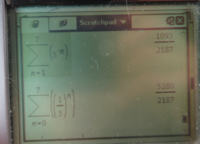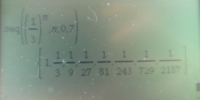To summarize my posts, the formulas that we are discussing work for sums where the powers are successive non-negative integers. Your fundamental problem was not working with powers of 1/3 rather than three to turn the exponents into positive integers.
The formula that I have memorized deals with a series where the initial exponent is zero. The one you seem to be familiar with starts deals with a series where the initial exponent is one. It is easy to derive one formula from the other; there is no inconsistency between tham. I have found the formula summarizing a series starting with an exponent of zero is easier to remember, but that is mere personal preference. In this case, the formula summarizing a series starting from an exponent of one is directly applicable to the given problem. There was nothing wrong with the formula you elected to use, but you needed to work consistently with (1/3) rather sometimes 3 and sometimes (1/3). By the way, the usual derivation of your formula is very elegant, but, in my opinion, it gives little or no insight into power series.
Finally, working with calculators avoids a lot of tedious work. But it comes at a double cost. We can never be sure that we entered stuff in the device correctly, which is why reasonable checks are crucial. Moreover, it tempts us to just start banging away on the calculator without giving a problem much thought. In the very first response, lev suggested working the problem out partially by hand, which I then did in full. And that resulted in confirming the calculator’s result. From that point on, the calculator issue was irrelevant. All that was relevant was what formula you were using and were you using it correctly.



